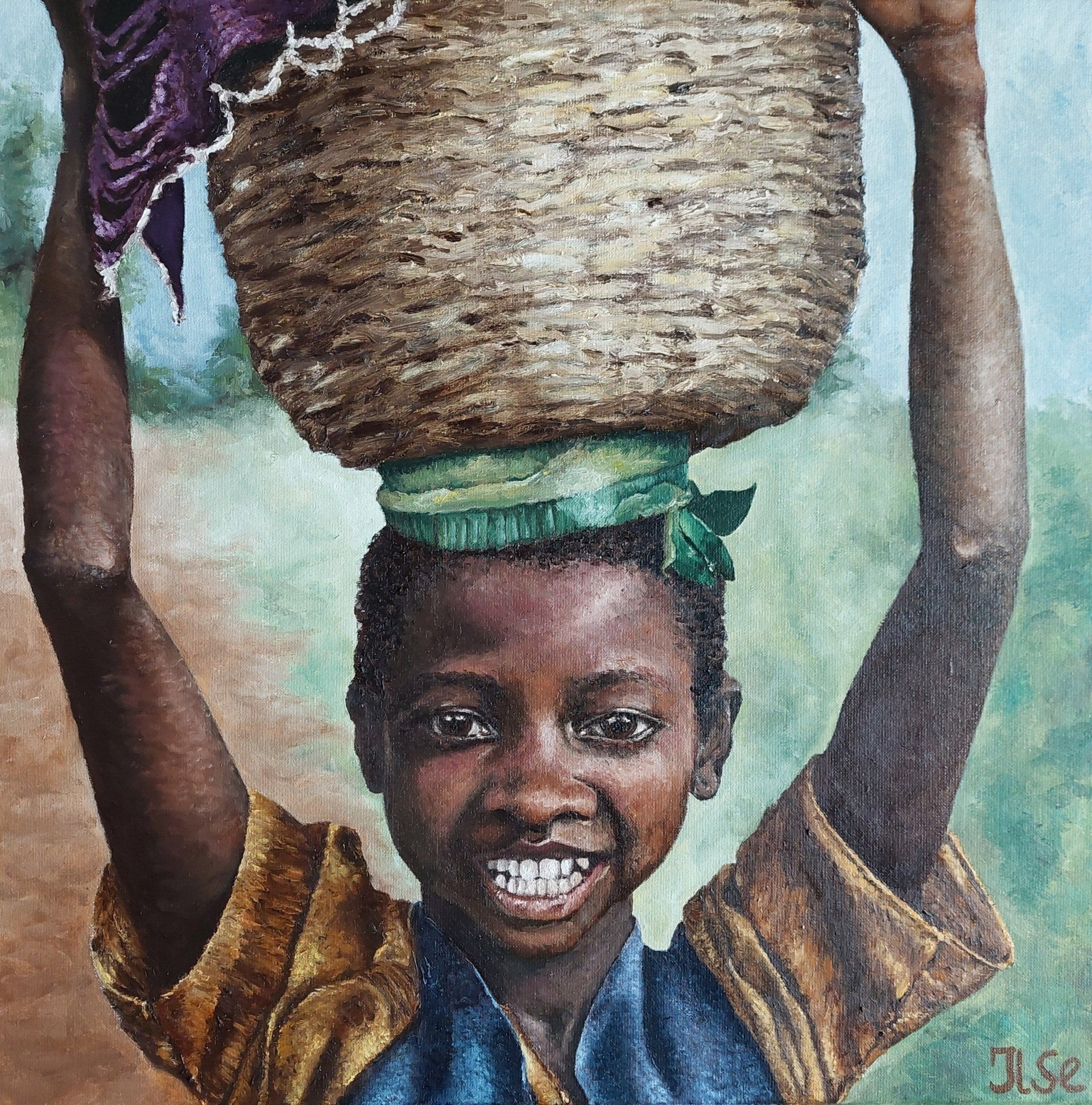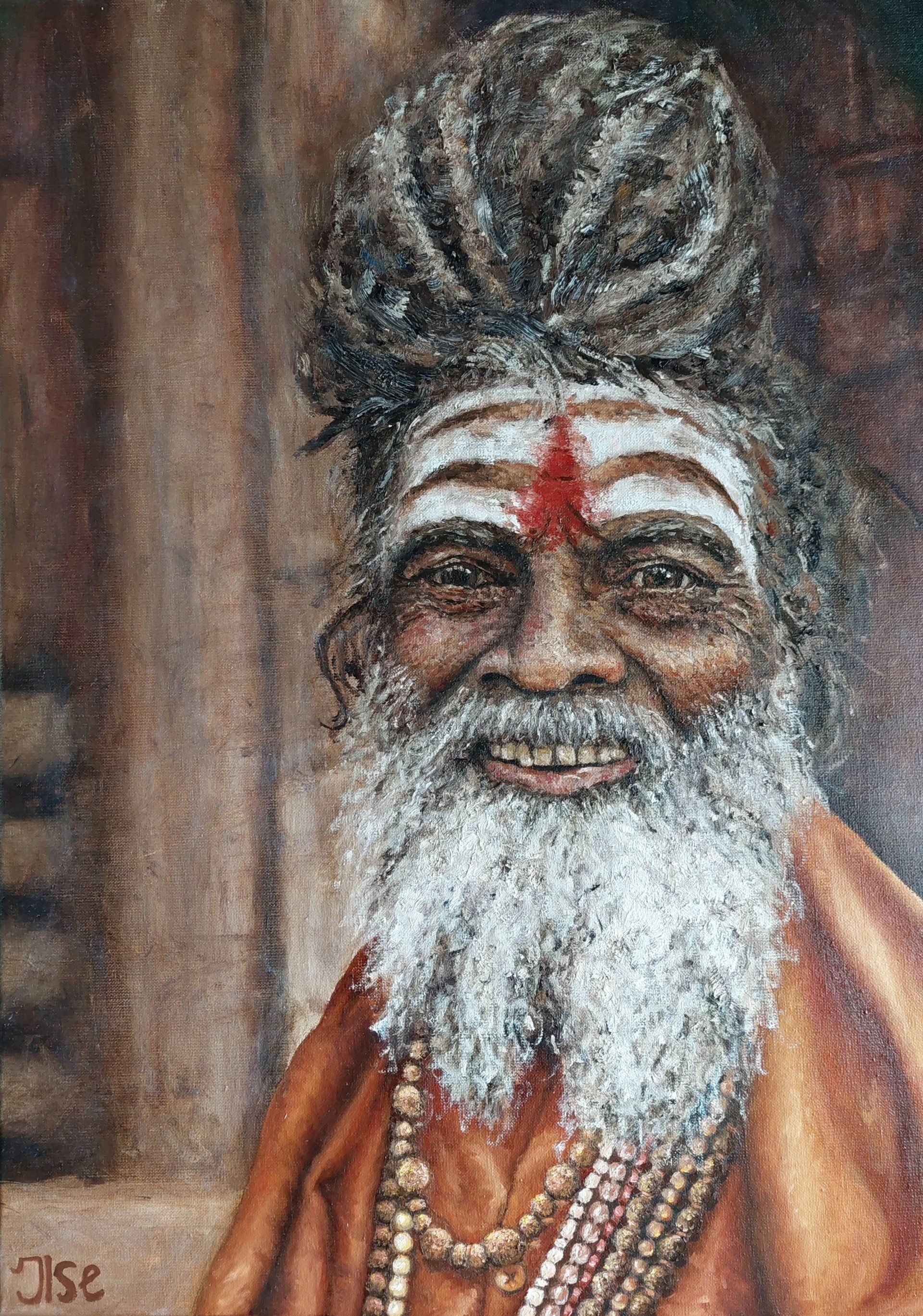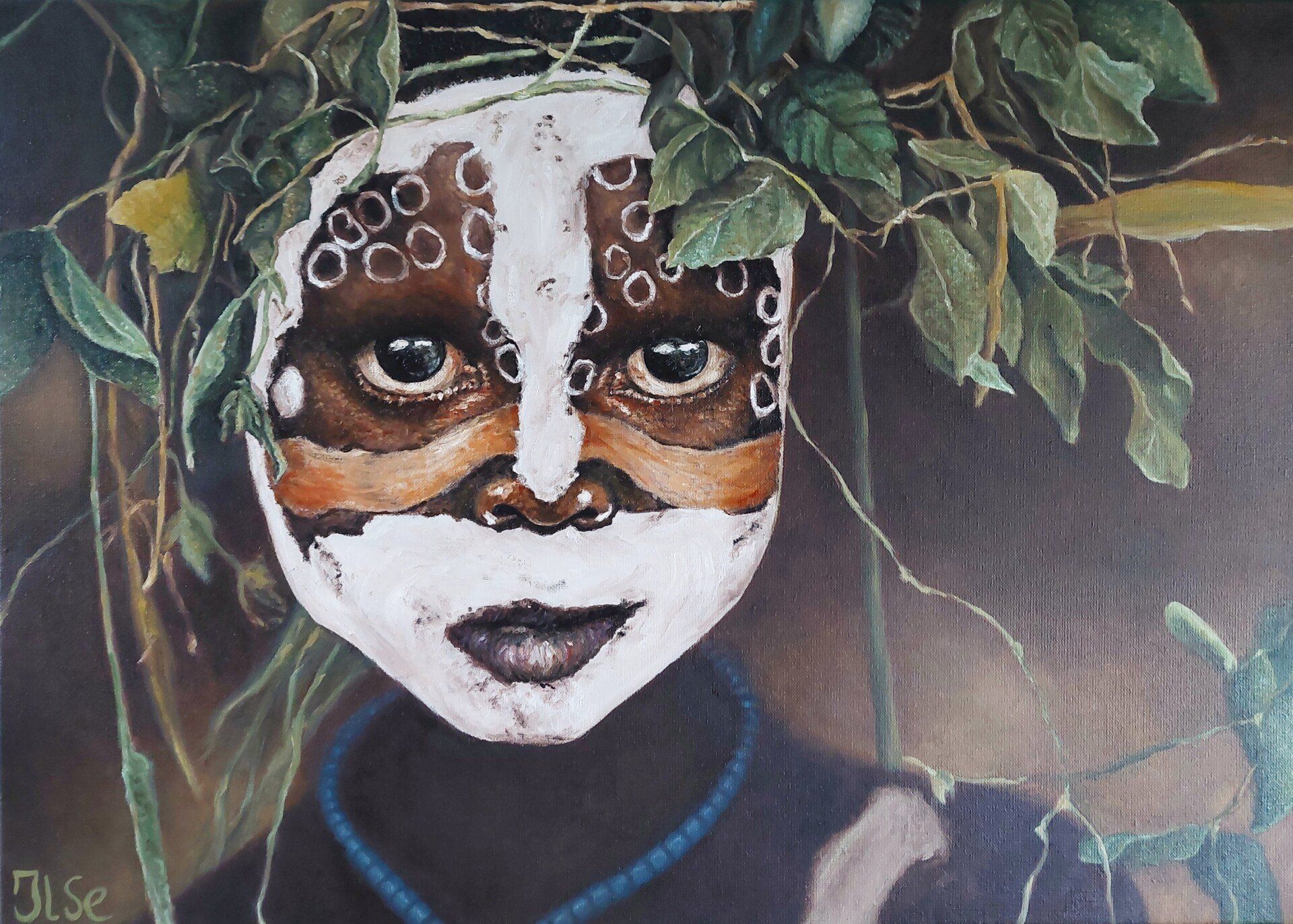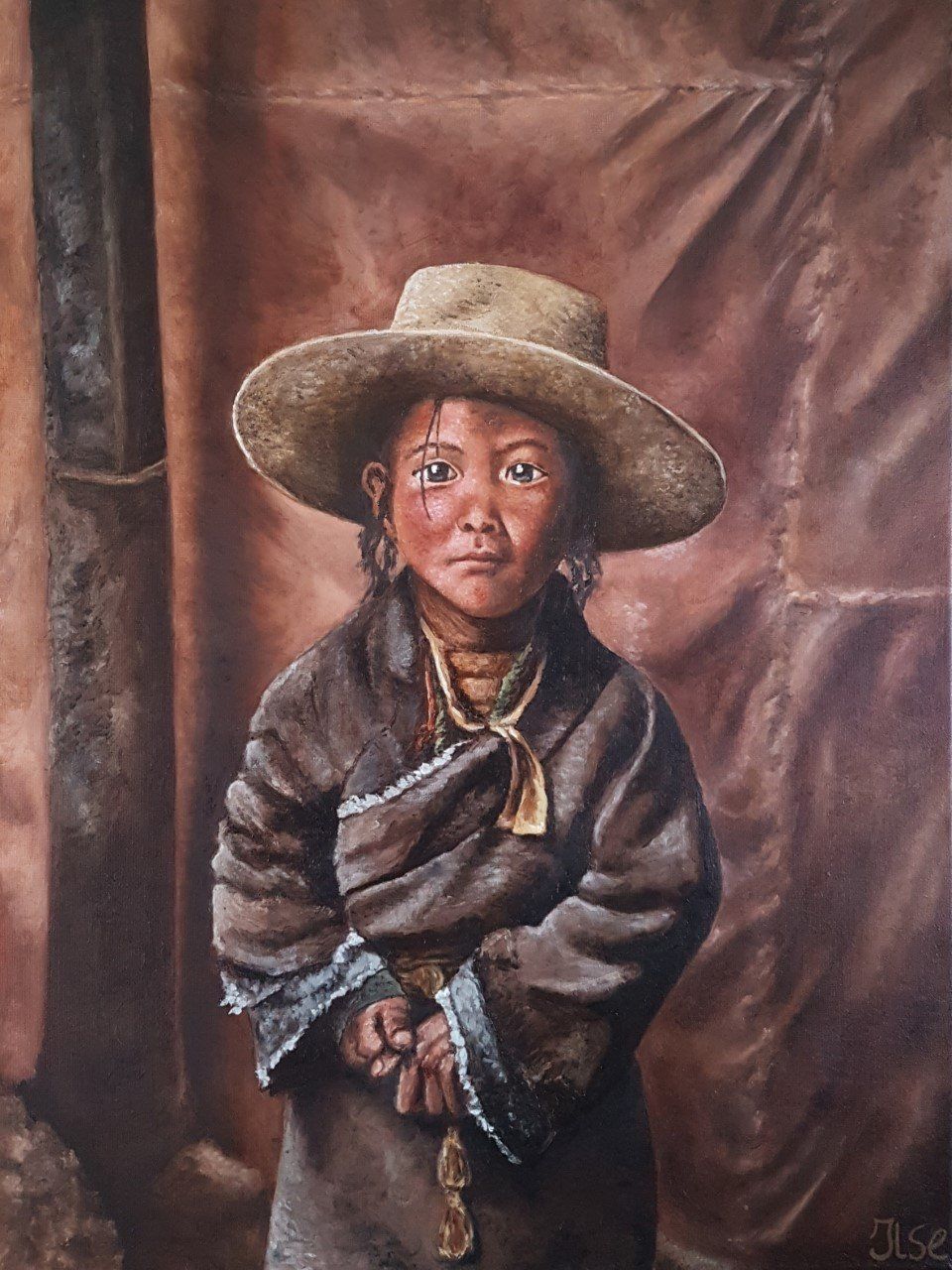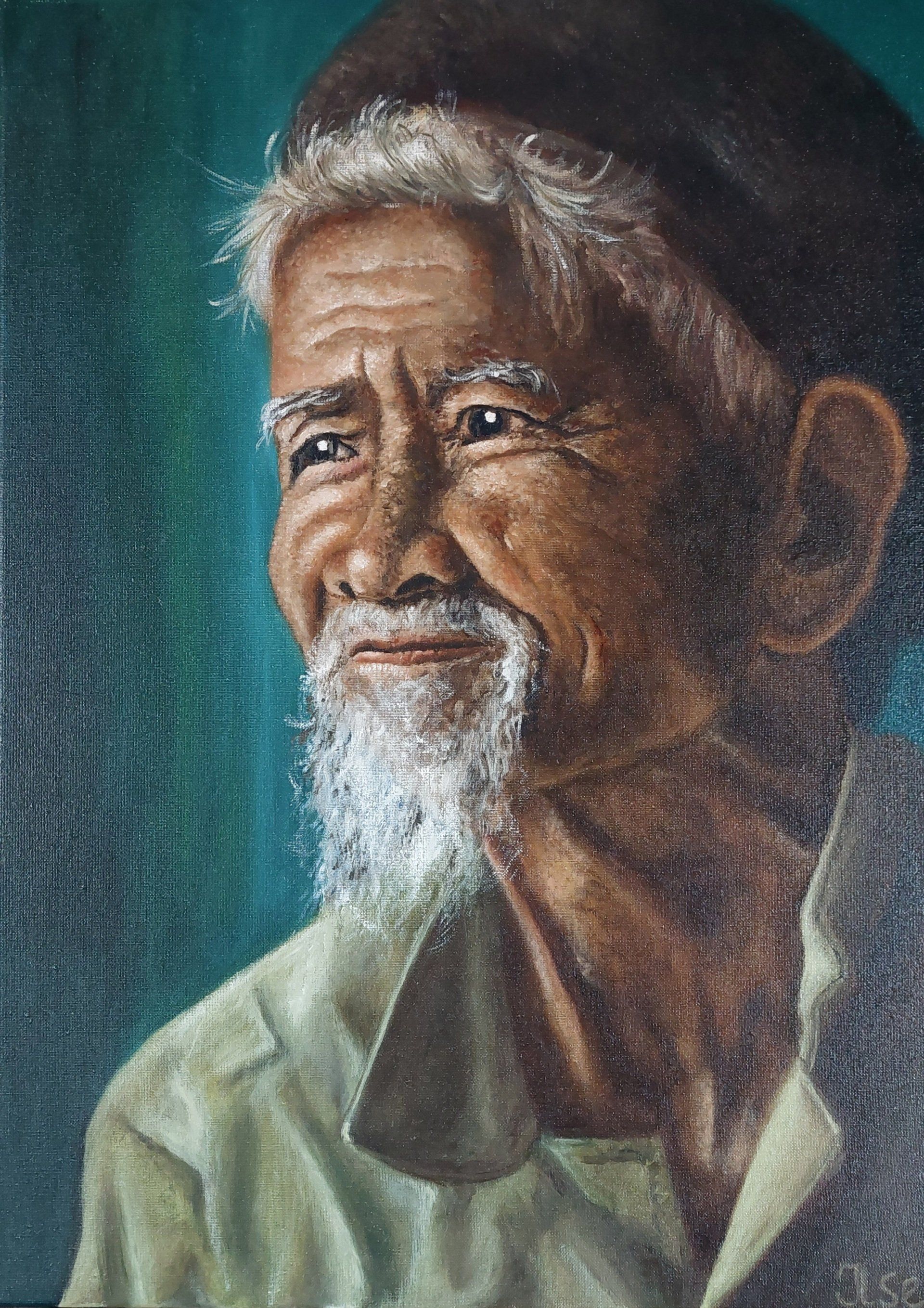Paintings
Primal Power
Oil on linen (100 x 70 cm)
For sale (995 euros)
This woman is from the Mentawai tribe. In the Mentawai tribe there is a strict division of labor between men and women. For example, women are responsible for catching fish. Using a fishing net, the women walk along the banks of the river to look for crabs, shrimps and small fish, which they store in a hollow bamboo tube. Their responsibilities are also visible on the woman's body. For example, the lines on her chest symbolize a fishing net and fishing hooks are visible on her hands. Traditionally, tattoos are made around the age of 18 or 19 with ink made from charcoal and sugar cane juice. They repeat the fishing trip along the rivers every 2-3 days and it is not without danger. Along the way, the woman reflexively dives into the bushes to heroically chase away a poisonous snake. Living from and with nature in the middle of the rainforest is not easy and requires an attitude of hard work. This is a real power woman!
The Flower Man
Oil on linen (120 x 80 cm)
For sale (995 euros)
This man is a shaman, a traditional healer, from the Mentawai tribe. Here a shaman is also called 'flower man' because he communicates with spirits through plants. At a very young age he was convinced of his calling as a shaman by visions of his ancestors and he apprenticed with his father. Shamans can cure people's ailments through rituals. The spirits of ancestors are evoked by means of 'chanting' in a secret language and the ringing of bells. Herbal mixtures are also used, rituals are performed to drive away evil spirits and sacrifices are made. As a shaman you live strictly according to certain secret rules. The shaman wears a traditional loincloth made from the crack of the gum tree. Tattoos on his body symbolize the tasks he has, such as hunting and responsibility for the family. For example, the lines on his chest symbolize the bow and arrow with which they hunt for example small monkeys.
Hope (1/2)
Oil on linen (50 x 70 cm)
Part of diptych
For sale: 1095 euros (for entire diptych)
These children are from the Dalit community, the lowest social class in Nepal. Opportunities for children born in this caste are limited. Discrimination and stigmatization are still commonplace. Although there is more awareness about child marriage, there is often no other choice due to a lack of money to send children to school. Yet a young man from this caste escaped his faith. He is not married and studied in the capital city. Now he tries to help the village through his foundation. There is hope that a new generation will emerge that can look beyond the caste divide. A generation that strives for equality and stands up for its rights. A generation that looks at similarities instead of focusing on differences. The way these children play with each other without discrimination, without judgement. That gives hope for the future.
Hope (2/2)
Oil on linen (50 x 70 cm)
Part of diptych
For sale: 1095 euros (for entire diptych)
These children are from the Dalit community, the lowest social class in Nepal. Opportunities for children born in this caste are limited. Discrimination and stigmatization are still commonplace. Although there is more awareness about child marriage, there is often no other choice due to a lack of money to send children to school. Yet a young man from this caste escaped his faith. He is not married and studied in the capital city. Now he tries to help the village through his foundation. There is hope that a new generation will emerge that can look beyond the caste divide. A generation that strives for equality and stands up for its rights. A generation that looks at similarities instead of focusing on differences. The way these children play with each other without discrimination, without judgement. That gives hope for the future.
Mapped out
Oil on linen (70 x 90 cm)
For sale (795 euros)
This woman is from the Dalit community, the lowest social class in Nepal. Once born into this caste, life is already set for you. A life without rights, of hard work and marrying young. In the past, children were measured using a stick. When they were tall enough, they could get married. This woman is originally from India, but around the age of ten she was married off to a boy from Nepal. She was carried to her new home on her brother's shoulders. A new country, a new village, a new family. Here she was expected to immediately start performing household duties. Her opinion was not asked. Life was already mapped out for her.
Child marriages still take place in Nepal, especially among lower castes. Although marriages under the age of 18 are officially banned, persistent poverty, lack of opportunities, age-old traditions and the caste system prove stronger than Nepalese law.
Injustice
Oil on linen (70 x 90 cm)
For sale (895 euros)
This man is from the Muhasar caste, the lowest social class in Nepal. Muhasar literally means "rat eater". This name comes from the time when the Muhasar caught rats that entrenched themselves in the rice fields and disrupted the harvest. The Muhasar caught the rats at the risk of their lives, because poisonous snakes also hid in the holes. The rats were eaten in times of scarcity. This man has experienced a lot of discrimination because of his caste. The lower castes were not allowed to touch food or drink, otherwise it was considered impure and immediately thrown away. When they made a mistake, they were beaten or even thrown out of the village. They were not allowed to own land. Instead, they worked hard for landowners from sunrise to sunset in exchange for food. Although much has changed, the castes still live separately from each other and the lower castes are still not seen as equal. Officially, the caste system no longer exists, but it will take many generations before the caste system disappears in practice.
Focus
Oil on linen (60 x 90 cm)
For sale (595 euros)
In the far north of Vietnam, close to the border with China, I get on the back of a motorbike for a four-day trip through the mountains: the Ha Giang Loop. Spectacular views follow one another. Via winding roads and hairpin turns we arrive at the top of a mountain. We are welcomed by a group of children. Several ethnic minorities live in this region. My focus immediately goes to a colorfully dressed girl. She seems focused on her job: to take beautiful yellow flowers up the mountain to the market. The focus radiates from her face. Here they are connected to the land and nature. Here the focus is on the little things in life, which make life so precious.
Resilience
Oil on linen (60 x 60 cm)
Sold
In 2016 I did volunteer work at a primary school in Uganda. One boy has always stayed with me: Emmanuel. A helpful, friendly boy with always a smile on his face even though he had been through a lot at his young age. He liked to help the teachers, but I saw him less with his classmates. He was the only one without a school uniform and he felt left out in his old clothes. When I gave him a school uniform, he smiled from ear to ear. His eyes beamed with pride. Too shy to say anything directly to me, he told one of the teachers how grateful he was. I saw something arise in his eyes, a certain power not to bring oneself down through the negative, but to bend it to the positive. What a resilience this boy has!
Wonder
Oil on linen (50 x 70 cm)
For sale (495 euros)
India - I walk towards the temple complex with my backpack on my back. Suddenly I come face to face with an older man in an orange robe. A Sandhu, either a religious ascetic, monk or holy person in Hinduism. Our eyes meet and for a moment we seem to be the only ones on this planet. We stare at each other. I wonder about his appearance. What will the red dot and white stripes mean? I am curious about his story, about his background, culture and customs. A smile appears on his face and we smile at each other. He is probably also wondering about by my appearance and might be curious about my story. We are so different, yet I feel the connection in the warmth of our smiles. We respect each other's presence. A moment of wonder, before we each go our separate ways.
Connection
Oil on linen (50 x 70 cm)
Sold
This African girl lives in the Omo Valley in Southern Ethiopia and uses facial paint for personal decoration, cultural expression, and insect repellent. She might look different, but behind the leaves and the paint, she is a human being with her own feelings and thoughts. No matter how different we look, act, or think, we are all connected to each other in certain aspects. Instead of looking at differences, we need to find those connections. Being connected to each other will learn us to respect each other as human beings, without prejudice. Never judge a book by its cover.
Warmth in Litang
Oil on linen (60 x 80 cm)
Sold
Background story:
This girl is from the town of Litang in Tibet. Many Tibetan Buddhist figures come from Litang, who provide reflection. Spirituality gives this girl an open mind. The large coat encloses her body and provides the necessary warmth at an altitude of 4000 meters. The warm colors of the painting contrast with the cold climate of Litang and show how affection and compassion can overcome this cold.
Uncle Mui
Oil on linen (50 x 70 cm)
Sold
Background story:
In 2018 I traveled through Southeast Asia for five months. In Central Vietnam I undertook a motorcycle tour led by a guide. I got on the back of the motorcycle and together with this guide I was able to discover the interior of Vietnam. Through my guide I was able to make contact with the local population, I learned more about them and I ended up in places where no tourists would go. It was a special adventure. I was always allowed to call my guide "Uncle Mui". That is why I named this portrait of a Vietnamese man after him.
Mama Gia
Oil on cotton (40 x 50 cm)
For sale (395 euros)
Background story:
During my journey through South East Asia in 2018, I arrived in Sapa, in the far north of Vietnam, in the middle of the night. Here I was welcomed by a woman and we reached her house in the mountains on foot. This woman makes her house available to tourists and takes you on hikes through the beautiful area. I will not soon forget the warmth and hospitality in this special place. The woman was called '' Mama Gia '' and that's why I named this portrait of a Vietnamese woman in Sapa after her.
Kirabo
Oil on linen (60 x 70 cm)
For sale (295 euros)
Background story:
In the summer of 2016, I went on a solo trip for the first time to Uganda. I volunteered there for a month at a primary school in Masaka. Prior to my trip I had raised money to spend this on the spot on bunk beds, school uniforms, food, textbooks, school desks, etc. I also handed out plush toys, helped with teaching and handing out food. It was very special to be able to mean something for these children, who were very grateful for the smallest things. During my stay I was given a Ugandan name: '' Kirabo '', which means gift. That is why I have named this portrait of an African woman ''Kirabo''.
Sacred Heart
Oil on linen (60 x 70 cm)
For sale (295 euros)
Background story:
In 2014 I was in South Africa to volunteer in an orphanage near Durban. This orphanage consisted of several houses in which children of different ages lived together with a house mother. As a volunteer I helped the house mother with various tasks, such as feeding, dressing and showering the children. It was very special to give these children the extra attention they needed. The house where I volunteered was called "Sacred Heart House". That's why I called this painting of a South African boy "Sacred Heart".









